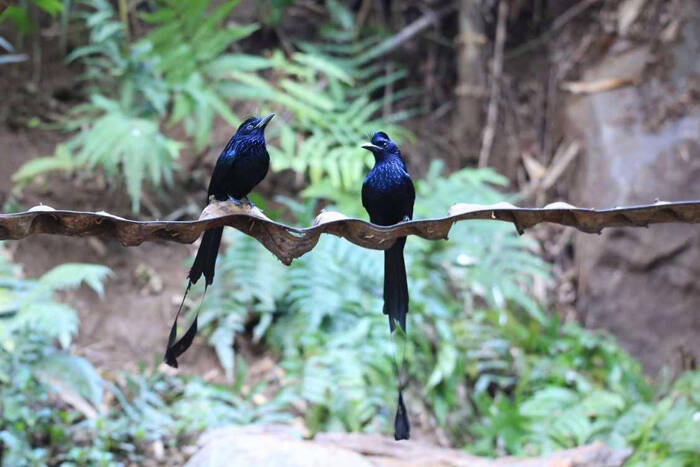Dicrurus remifer
IUCN
LCBasic Information
Scientific classification
- name:Dicrurus remifer
- Scientific Name:Dicrurus remifer,Lesser Racket-tailed Drongo,Small tennis ball
- Outline:Songbird
- Family:Passeriformes Drongo
Vital signs
- length:44-58cm
- Weight:40-48g
- lifetime:No verification information
Feature
The outermost pair of tail feathers is very elongated
Distribution and Habitat
Distributed in Bangladesh, Bhutan, Cambodia, China, India, Indonesia, Lao People's Democratic Republic, Malaysia, Myanmar, Nepal, Thailand, Vietnam.
In China, it is distributed in Dehong in western Yunnan, Xishuangbanna, Simao, Yuanjiang and Wenshan in the south, and Longzhou in Guangxi.
It lives at an altitude of about 890-1010 meters. It is a bird of tropical broad-leaved rain forest in mountainous areas; it lives in open grasslands between forests, open river banks between valleys, or wet swamps. It also appears in bamboo forests, small pieces of jungle near farmlands and villages, orchards, sparse forests and grass slopes and other open areas.
Appearance
The small plate-tailed male adult bird is all black with purple metallic flashes; the forehead feathers at the base of the bill are tufted black feathers and extend forward on the peak of the bill. The peak of the bill is completely covered with tufted feathers except the tip; the forehead and eyes are first The feathers on the head, cheeks and ears are black; the head and neck have scaly spots with metallic luster; the back, shoulders, waist and tail coverts are black with purple-blue luster; the wing feathers are dark brown with a metallic luster on the outer feathers; the tail feathers are dark brown with outer feathers It has a metallic luster, and the outermost pair of tail feathers is very elongated. The feather shaft is partially exposed, and the inner and outer feathers at the end are symmetrical to each other in a "plate-tail shape". The other inner tail feathers are normal, only about 1/ of the length of the outermost pair of tail feathers. 3. The underparts are bla
Details
Lesser Racket-tailed Drongo has four subspecies.

Lesser Racket-tailed Drongo often stays on the top of isolated trees for a long time, and sometimes suddenly flies up quickly to catch flying insects in the air, or fly through dense trees. It flies slowly, with the "disk-shaped tail" of the tail feathers behind its body fluttering and dancing, sometimes rising rapidly, and then somersaulting down, preying on insects startled and flying from the marsh grass.
The small disc-tail mainly feeds on insects such as locusts and grasshoppers, and also eats the stamens and berries of plants. It usually stands high in the trees to spy on the surrounding movements. When it finds prey, it immediately flies to catch it, and then flies back to the original place to devour it.
The call of the small disc-tail: a changeable and pleasant flute sound weet-weet-weet-weet-chewee-chewee, with many changes in melody, and occasionally a hoarse and harsh call. And it is good at imitating other birds' calls.
The breeding season of the small disc-tailed eagle is about March-June. The nest is mostly placed on the end of some small branches at the top of the broad-leaved tree. The nest is cup-shaped, similar to other species of the family Curculionidae. It sways in the wind like a child's cradle. The nest is mainly made of twigs, reed stems, roots and dead grass, and is firmly fixed on the branches. There are spider webs on the outer wall of the nest, and sometimes it is decorated with some moss, lichens and bark, etc., more than 5 meters above the ground. Each nest lays 3-4 eggs. The eggs are of two types: long oval and pointed oval, mostly white, occasionally milky white, with two layers of light red, brown or purple markings, especially denser at the blunt end.
Listed in the "Red List of Endangered Species of the World Conservation Union" (IUCN) 2016 ver 3.1-Least Concern (LC).
Listed in the "National List of Terrestrial Wildlife with Important Economic and Scientific Research Value" (Item 397) issued by the State Forestry Administration of China on August 1, 2000.
Listed as a rare species in the "China Red Book of Endangered Animals·Birds".
Listed in the second level of China's "National Key Protected Wildlife List" (February 5, 2021).
Protect wild animals and stop eating game.
Maintaining ecological balance is everyone's responsibility!








